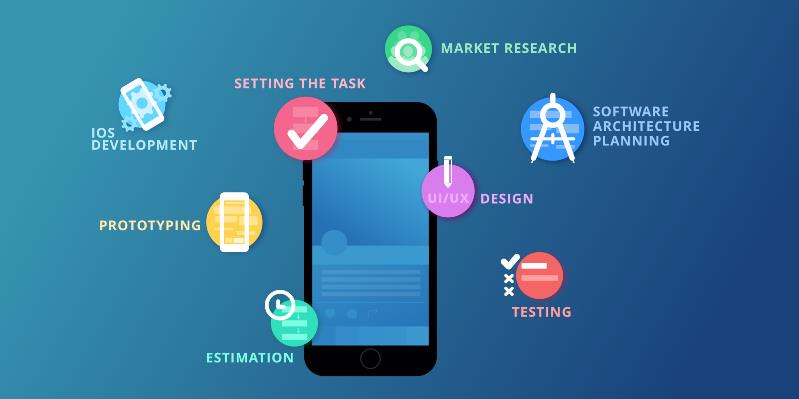Longrid design of a mobile application from a drawing to a masterpiece
The mobile app market is extremely competitive. Application design is one of the keys to success for project profitability.
Design is not only tons of sketches and the “pay” button. It is important to include psychology, aesthetics, behavioral sciences, and testing.
Top app development companies always carefully approach the creation of the interface of new services. What does the client need to know and what requirements should be presented to the team so that the work meets expectations?
Let's talk about the stages of creating a mobile design!
4 steps to create a mobile application
- Understanding Your Users
- Layouts
- Design
- Testing
Understanding Your Users
How to develop a user interface for mobile applications? First, you need to know your users.
Understand what motivates them to use your application, and then start development.
There are several ways to better understand who your users are, what their intentions are, their needs and their general ways of thinking. One of them is to evaluate user scenarios with characters and create a mood board.
Answer the following questions:
- Who are your users?
- How do they behave?
- How do your users feel after using the app?
If you do not know who your target audience is, then you do not make applications for people. The client is a priority in business, and your project should meet the needs of the user.
After you receive answers to these questions, you will understand how the user interface of your application should look. Then move forward, creating templates and designs for mobile applications.
Why is this information important?
Creating a clear profile of the client will help determine the requirements for the design of the application: does the function, design element, button fit the user's needs:
- How will this element help the user?
- Will the button allow the client to achieve his goals?
- If we did not add this feature, would the client achieve his goals?
Since our client is a busy person, we put all the elements that are necessary to order a service on one screen. It often happens that app developers spend time creating features and screens that are never used. A profile of the target audience helps to avoid this problem and provides information that is necessary to satisfy the end-user’s goals.
Another important step in the development of user scenarios - the life situations of using the application. This helps to better understand how to arrange the function buttons and which of them are needed and which are not.
Mood board
The “mood board” helps create the color scheme of the application that will evoke the emotions and feelings you need.
For example:
green: nature, trust, life;
blue: sky, purity, brilliance;
Choosing such colors for the service, the app developers lay down certain sensations of the client when using it.
Create templates
Wireframes are interface layouts for your future mobile app. It all starts with sketching on paper. They create templates for each application screen.
- Design
What needs to be paid special attention during application design?
When creating an application, the developer is faced with a big problem - how to find a balance between performance, appearance, and usability.
- Look and feel
User experience or UI is an important part of creating a design. The UI tells us how the user feels the product during and after work. The Mood board, which we have already talked about, is one of the tools for a good UI.
- The convenience of use
The ease of use or usability of the application provides ease of use and an intuitive interface.
This means that the user is easily oriented in the application environment and quickly performs his tasks.
It is easy to cope with this task if you carefully study the first paragraph of our article.
Testing
When the design of the mobile application is ready, it needs to be tested. This helps to identify flaws and present the perfect product to customers.
How to test the application?
- Focus groups
Focus groups allow you to receive feedback on a new design from a large number of people. Target groups are made up of users who can give you important information about the usability of the application.
In other words, create a profile of your user, find as many of these people as possible and let them test the application.
- Iterations
Iterative testing involves new testing every time you introduce a new feature. This allows you to quickly check whether users can satisfy their needs.
A/B Testing
A/B testing is a comparison of two versions of a design. Create two separate versions A and B with the features or characteristics that you want to compare. Then check the versions on the focus groups. This approach allows you to test new ideas, check whether the new design is better than the previous one.
To reach the final version of the mobile design of the application, it takes enough time and effort. But the result will live up to expectations, you will create a service for the target audience that will be happy to work with him.
Now you know what the design of your dream startup should be and how professionals should work.
Related Posts
The rapidly changing landscape of e-commerce demands businesses to create a compelling online presence. However, establishing a formidable online store demands much more than a mere digital replica of a physical storefront. It requires a deep understanding of human psychology and a strategic...
Recently, stock photos have become a popular choice in design.
With the digital world picking pace and setting high benchmarks for the upcoming ideas in the industry, the upcoming digital decade is likely to experience much improved and robust digital ideas.
AI has been around for a while and the automation of numerous business processes and systems has arguably been the precursor of the current debate and the basis for practical development of AI.
There is so much information out there to help people struggling with too much clutter in their homes, but not nearly as much about digital clutter.


















Comments
comments powered by Disqus